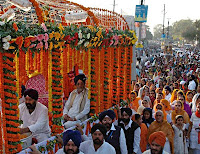Every cold damp week of November opened up a window to display India in all its warm hues and diverse culture.
Here in Meghalaya and elsewhere, Hindus, Muslims, Christians, Sikhs, Jains and indigenous communities all showcased their happier and solemn sides during this “implacable November” as Charles Dickens would say.
November started on a somber note with Christians observing the All Soul’s Day on November 2. Christians remembered their departed soul and visited the graveyards with freash flowers and candles on the occasion.

 The next week on November 9, the Garo Community celebrated the Wangala Dance festival marking the end of harvest and the beginning of winter season. During thecultural fiesta, dancing troupes from ten villages from all over Garo Hills, including Bangladesh, exhibited their dancing prowess attired in colourful and exotic tribal costumes to the beats of hundred ‘damas’ or drums at Asanang, West Garo Hills .
The next week on November 9, the Garo Community celebrated the Wangala Dance festival marking the end of harvest and the beginning of winter season. During thecultural fiesta, dancing troupes from ten villages from all over Garo Hills, including Bangladesh, exhibited their dancing prowess attired in colourful and exotic tribal costumes to the beats of hundred ‘damas’ or drums at Asanang, West Garo Hills .


 Although it is “hard to hold a candle, on a cold November rain” as Guns and Roses complains, but, exactly seven days later on November 13, Hindus celebrated Diwali or Deepawali with lights, candles, earthen lamps and fireworks. Kali and Lakshmi Pujas were also held on this day.
Although it is “hard to hold a candle, on a cold November rain” as Guns and Roses complains, but, exactly seven days later on November 13, Hindus celebrated Diwali or Deepawali with lights, candles, earthen lamps and fireworks. Kali and Lakshmi Pujas were also held on this day.
The festival of light brightened up the otherwise cold damp November as Hindus celebrate the day to mark the sweet homecoming of Ram, Laxman and Sita to Ayodhya after fourteen years in exile, not before defeating the demonic Ravan.
The day is also celebrated by the Jains as Deva Devali. On this day, Lord Mahavir founder of Jainism attained Nirvana or Moksha in 527 BC.
The next day was Children’s Day, the birthday of India’s first Prime Minister Pandit Jawaharlal Nehru. During the day various programmes were held in schools and colleges and kids got free sweets!

 Again next week on November 23, the Khasi community professing the indigenous way of life, Niam Trai Niam Tre, celebrated the Seng Kut Snem, again a post harvest celebration. Colourful processions were taken out with elaborate tableaux to celebrate the day. The occasion is also observed to pay obeisance to the deities for protection of the local indigenous faith and providing a bountiful harvest.
Again next week on November 23, the Khasi community professing the indigenous way of life, Niam Trai Niam Tre, celebrated the Seng Kut Snem, again a post harvest celebration. Colourful processions were taken out with elaborate tableaux to celebrate the day. The occasion is also observed to pay obeisance to the deities for protection of the local indigenous faith and providing a bountiful harvest. Just two days and beginning of the week, Muslims observed Muharram. During the occasion members from the Shia community took out procession to commemorate the martyrdom of Prophet Muhammad’s grandson, Imam Hussein and three days later Guru Nanak’s 544th Birthday – the founder of the Sikh religion - was celebrated by the Sikh community as Guru Nanak Gurupurab.
Just two days and beginning of the week, Muslims observed Muharram. During the occasion members from the Shia community took out procession to commemorate the martyrdom of Prophet Muhammad’s grandson, Imam Hussein and three days later Guru Nanak’s 544th Birthday – the founder of the Sikh religion - was celebrated by the Sikh community as Guru Nanak Gurupurab. Grand processions were taken out with skilful performance of martial art, songs and dances. Later prayer services were held at the local Gurdwaras followed by offering of a sweet dish or Karah Prasadmade from Semolina. And now with December round the corner, the festive season is headed for a grand finale.
Grand processions were taken out with skilful performance of martial art, songs and dances. Later prayer services were held at the local Gurdwaras followed by offering of a sweet dish or Karah Prasadmade from Semolina. And now with December round the corner, the festive season is headed for a grand finale. 





































